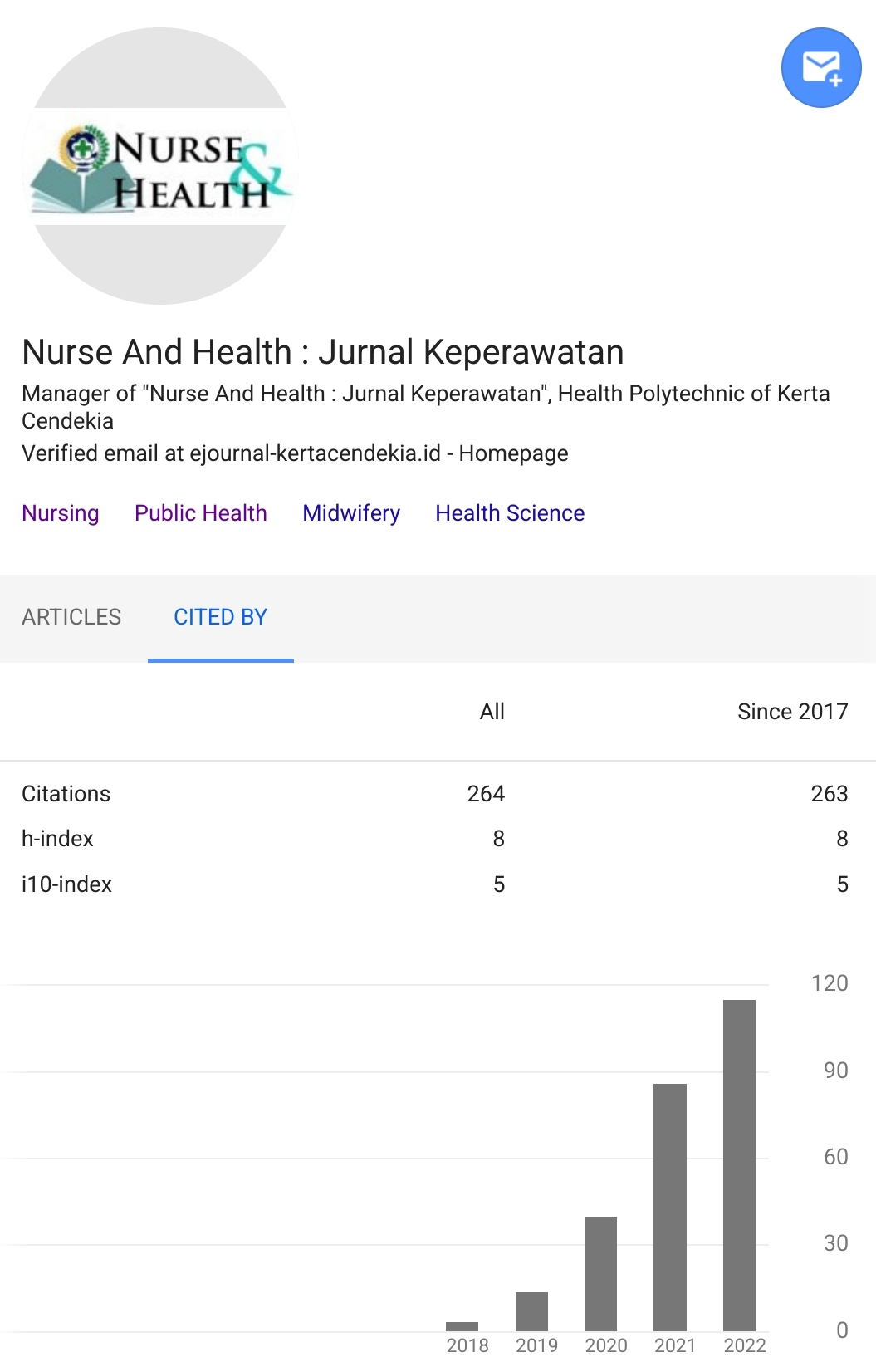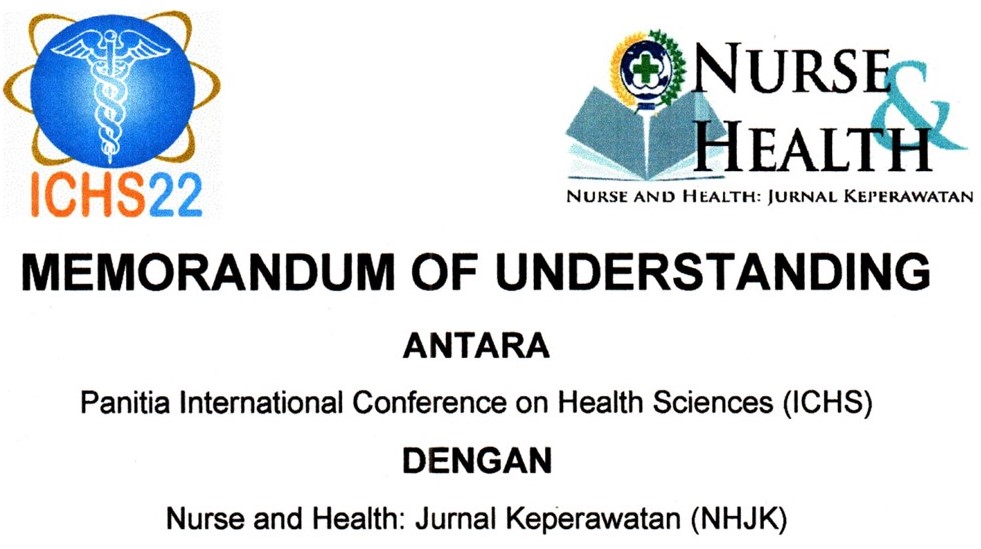THE RELATIONSHIP BETWEEN JEAN WATSON'S THEORY OF HELPING TRUST WITH PATIENT SATISFACTION
Abstract
Background: Fostering a trusting relationship between nurses and patients is the development of one of the curative caring factors because it is closely related to the acceptance of positive and negative feelings of patients when receiving services from nurses. The quality of a person's relationship with others is an element that determines the caring behavior of a nurse (Sartika, 2011). Nurses must be patient, generous, willing to provide assistance to patients voluntarily and be able to communicate, work and be responsible for their duties and rights when acting (Nursalam, 2013).Objectives: The purpose of this study was to determine Jean Watson's theory of helping trust with patient satisfaction in the inpatient room in The Government Hospital of Tangerang Regency.Methods: The research design used in this study is descriptive correlation using the Cross-Sectional approach. The population used in this study were patients treated in the inpatient rooms of Government Hospital of Tangerang Regency amounting to 80 people. The sampling method used is the non-probability sampling method. The sampling technique in this research is purposive sampling. The sample used in this study were 65 respondents. This research instrument using a questionnaire. The analysis used the Chi square test with a significance level α < 0.05.Results: Jean Watson's helping trust relationship both 13 respondents (34.2%) and those who were not satisfied were 1 respondent (3.7%). the results of the analysis obtained OR = 25.35 means that patients who claim helping trust relationship Jean Watson have a 25.35 times chance expressed satisfied. Chi square test results obtained p value 0.001 so that it can be concluded that there is a significant relationship between Jean Watson’s theory of helping trust relationship with patient satisfaction in class III inpatient room at The Government Hospital of Tangerang Regency.Conclusion: Patient satisfaction depends on the quality of nursing services. Service is said to be good if in fact the nurse provides the needs according to the patient's condition and the patient's response to service can be disappointing or satisfying. Further research is expected that nurses can provide assistance to the relationship of trust to patients so that patients can feel safe and comfortable when nurses take nursing actions to patients. Further researchers can use other research methods either qualitatively or add other variables so that the helping trust relationship between nurses and patients can be well developed. Keywords: Helping Trust Relationship, Patient, Satisfaction, Jean Watson.Downloads
References
Alligood, M.R., Tomey, .M (2010) Nursing Theorist: and their work. Misouri: Mosby Elsevier.
Arikunto. (2014). Prosedur Penelitian Suatu Pendekatan Praktik. Jakarta: Rhineka Cipta.
Budiman, A.R. (2013). Pengetahuan dan Sikap Dalam Penelitian Kesehatan. Jakarta: Salemba Medika.
Burnard, P., Morrison, P. (2009). Caring & Communicating alih bahasa Widyawati. Edisi 2. Jakarta: EGC.
Dahlan, M. S. (2014). Statistik Untuk Kedokteran Dan Kesehatan Edisi 6. Jakarta: Salemba Medika.
Dharma, K. K. (2011). Metodologi Penelitian Keperawatan: Panduan Melaksanakan dan Menerapkan Hasil Penelitian. Jakarta: Trans InfoMedia.
Hafid, M.A. (2014). Hubungan kinerja perawat terhadap tingkat kepuasan pasien pengguna yankestis dalam pelayanan keperawatan di RSUD Syech Yusuf Regency Gowa. Jurnal Kesehatan, VII (2), 368–375.
Kozier, B., Erb, Berman., S. (2014). Kozier and Erb's fundamental od nursing (Autralian ed). Melbourne: Austalia.
Manurung, S., Hutasoit. M.L.C. (2013). Persepsi Pasien Terhadap Perilaku Caring Perawat di Ruang Rawat Inap Rumah Sakit. National Public Health Journal Volume 8 (3), 104-108.
Martiningtyas, et al. (2013). Hubungan Caring
Perawat Pelaksana dengan Kepuasan Pasien Di Rawat Inap RSUD Dr. H Soewondo Kendal. Retrieved from http://ejournal.stikestelogorejo.ac.id.
Muninjaya, A.G. (2005). Manajemen Kesehatan (Edisi 3). Jakarta: Kedokteran EGC.
Nursalam. (2013). Manajemen Keperawatan, Konsep dan Praktik. Jakarta: Salemba Medika.
Potter, P.A., Perry, A.G. (2011). Buku Ajar Fundamental Keperawatan. Jakarta: EGC.
Satrianegara, F. (2014). Organisasi dan Pelayanan Kesehatan. Jakarta: Salemba Medika.
Sartika, N. (2011). Konsep Caring Menurut Jean Watson. Retrieved from https://www.pedomannews.com.
Simamora, R.H. (2012). Buku Ajar Manajemen Keperawatan. Jakarta: EGC.
Sugiyono. (2016). Metode Penelitian Kuantitatif, Kualitatif dan R&D. Bandung: Alfabeta.
Sujarweni, V., Endrayanto, P. (2012). Statistika Untuk Penelitian. Yogyakarta: Graha Ilmu.
Sukesi. (2013). Upaya Peningkatan Caring Perawat Terhadap Kepuasan Pasien Diruang Rawat Inap RS Permata Medika Semarang. Jurnal Managemen Keperawatan, 1 (1), 15-24.
Supranto. (2011). Pengukuran Tingkat Kepuasan Pelanggan Untuk Menaikan Pangsa Pasar (Cetakan Ke-4). Jakarta: Rinneka Cipta.
Suyanto., Salamah. (2009). Riset Kebidanan: Metodologi dan Aplikasi. Yogyakarta: Mitra Cendekia Press.
Yusuf, S. (2004). Mental Hygiene: Perkembangan Kesehatan Mental Dalam Kajian Psikologi Dan Agama. Bandung: Pustaka Bani Quraisy.
Yasmini. (2015). Hubungan Caring Perawat Pelaksana Dengan Kepuasan Pasien di Ruang Rawat Inap SMC Rumah Sakit Telogorejo. Jurnal Kesehatan STIKES Telogorejo Semarang.
Widiyatun, T. R. (2009). Ilmu Perilaku. Jakarta: CV. Sagung Seto.
Authors who publish with Nurse and Health: Jurnal Keperawatan agree to the following terms:
- Authors retain copyright licensed under a Creative Commons Attribution-NonCommercial 4.0 (CC BY-NC 4.0), which allows others to remix, tweak, and build upon the authors' work non-commercially, and although the others' new works must also acknowledge the authors and be non-commercial, they don't have to license their derivative works on the same terms.
- Authors are permitted and encouraged to post their work online (e.g., in institutional repositories or on their website) prior to and during the submission process, as it can lead to productive exchanges, as well as earlier and greater citation of published work (See The Effect of Open Access). Authors can archive pre-print and post-print or publisher's version/PDF.








_resize1.jpg)















